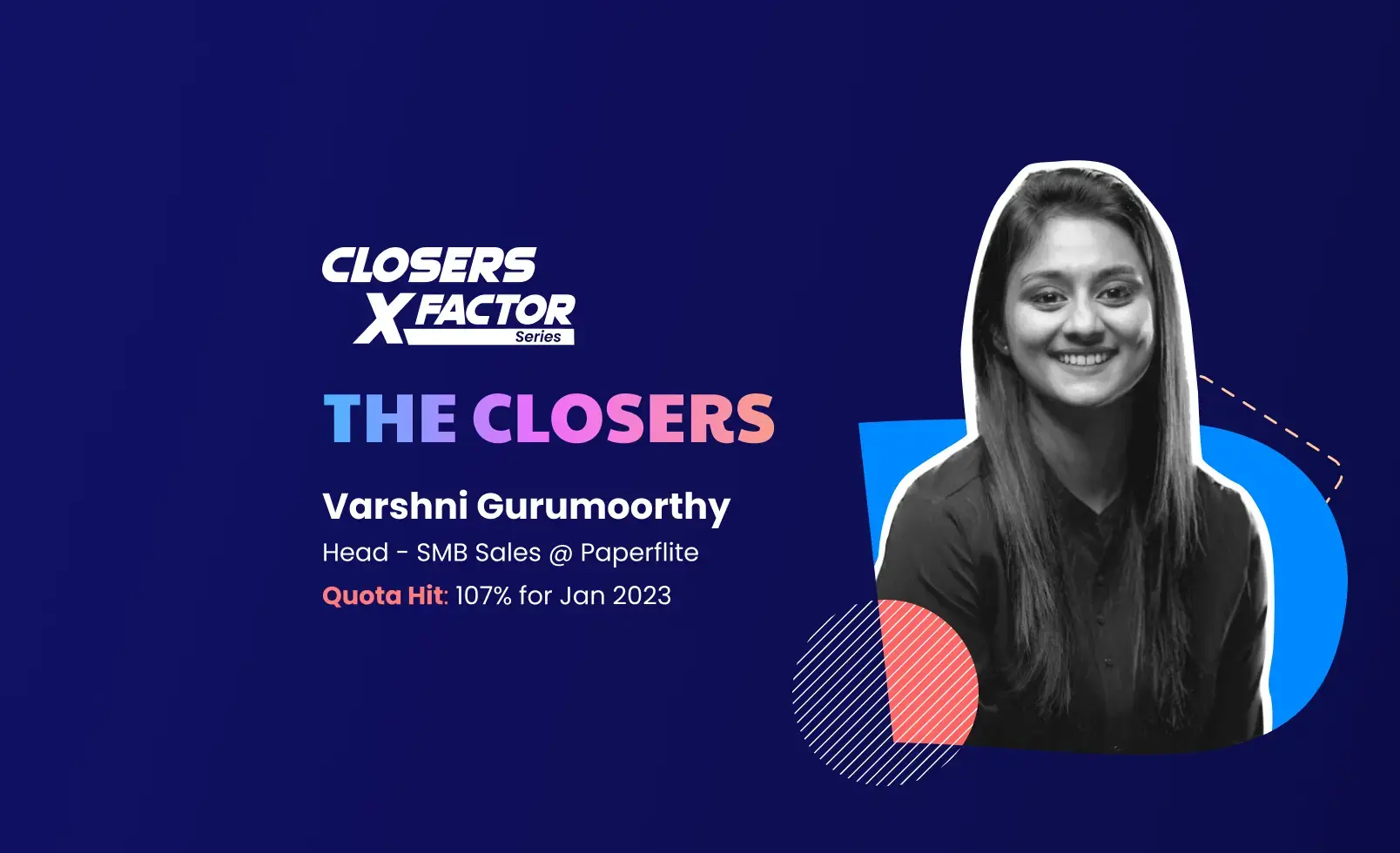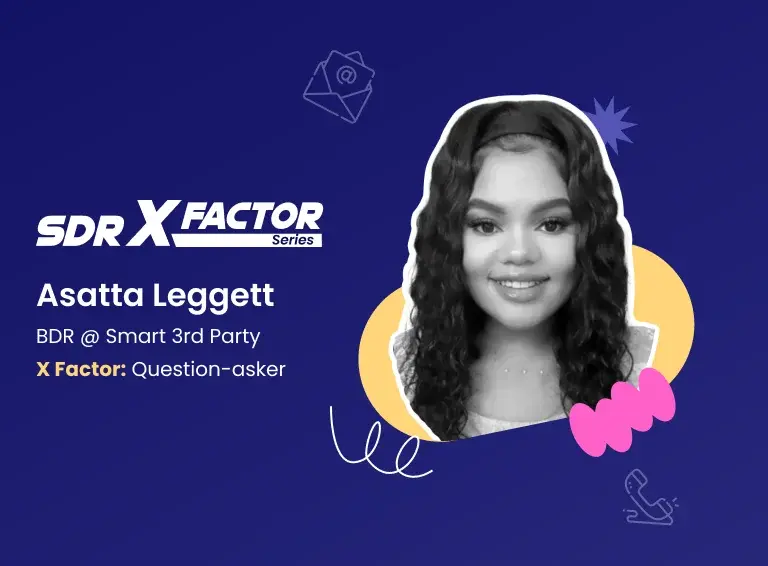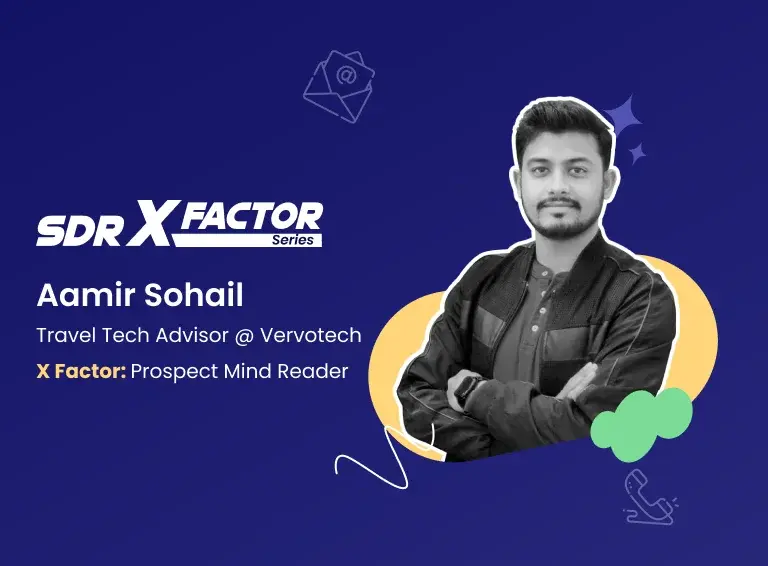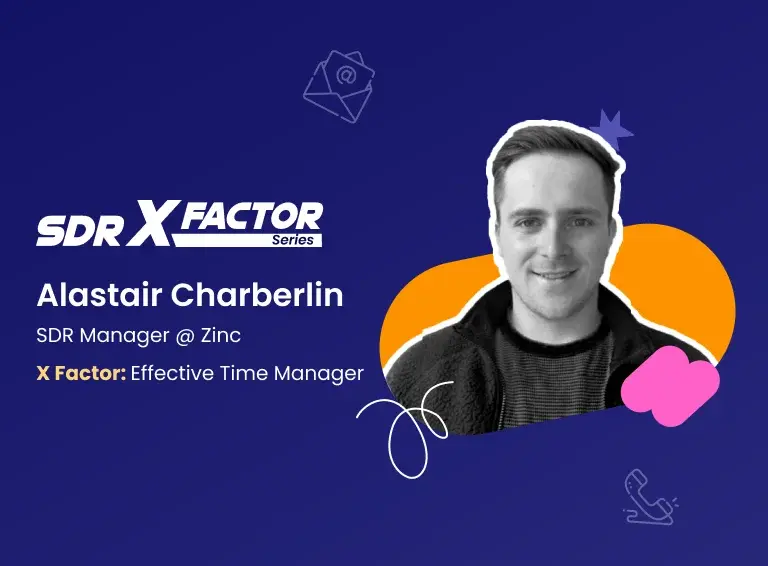Varshni Gurumoorthy began her career as a network engineer. Over a year later, she switched to an AE role at Paperflite. After merely 2 years in the position, she now heads the New Business efforts for SMB at the organization. We can’t help but wonder what the secret to her success is. How is she so good at closing deals?
In this first chapter of the Closers X Factor series, we pull back the curtains behind her winning discovery, demo, and negotiation strategies that have made her a top-performing AE, who consistently exceeds quotas month after month.
1) Varshni’s Formula for a Successful Sales Call
Varshni usually combines the discovery and demo for most prospects in one video call. The video call is scheduled for 30 minutes.
This is how she makes the most of the duration:
- 3 minutes of rapport building,
- 7 minutes of the discovery process,
- 15 minutes for the demo, and
- 5 minutes for discussing pricing, onboarding, and next call if required.
“If they're like a very small startup, everything is done in that 30 minutes per se. But if it is an enterprise level conversation, it probably is going to get stretched out.”
2) How Many Questions Does It Take To Crack Sales Discovery?
Varshni’s discovery process involves 12 questions, which she uses to qualify leads. These questions are loosely based on lead qualification frameworks like MEDDPICC and BANT.
To make her conversation less interrogative, she gets the answers to 5-6 questions out of the 12 qualification questions through research. Instead of asking those questions, she brings up the answers she found as part of the conversation and clarifies them.
Her 12 questions include:
- “What prompted this discussion (about the solution) in your organization?”
- “What are the problems you're facing that you’d like to change?”
- “How familiar are you with this ecosystem?”
- “Are you evaluating somebody with us at this point in time?”
- “Who on the team would use the tool?”
“This is not an interrogation, and you should never make them feel like that. It's always a good mix of give and take.”
3) Here’s How To Sidestep Landmines While Building Rapport
To make rapport building easier, Varshni refrains from expressing strong opinions about any controversial topics, like political issues, during the conversation with prospects.
While she touches on where they're from and their background, she chooses to stay neutral about any topics that they discuss in the initial minutes of the call.
“Never step into a conversation with a preconceived notion, because that not only talks about you, but also talks about your brand.”
4) The Art of Un-Zoning Prospects Who Zone Out
During the discovery call, Varshni pays close attention to the non-verbal cues of prospects that indicate they’re distracted or zoning out. These include prospects leaning back on their chair, or constantly avoiding eye contact.
To win their attention back, she calls them out tactfully.
- If the prospect keeps looking away from the screen, she’d say: “Hey, {first name}, looks like you probably got a message that you need to attend to. I could definitely give you a couple of minutes. And we can go back to this.”
- Towards the end of the meeting, if the prospects seem agitated, she stops sharing the screen and says: “Hey, I know that you're probably a little anxious to prepare for the next meeting or whatever's coming up for you next. I'd love to use the last couple of minutes to schedule another time, so we can pick up exactly where we left.”
During demos, when prospects seem too quiet, she usually asks them if a particular team member would benefit from a specific feature, as in:
- “John from your team would highly benefit from this. Do you think he will like it?”
This way, the prospect will brisk up as they have to put themselves in another person’s shoes, and they’ll remain interested and conversational for the rest of the demo.
5) Identifying Champions With a Little Help From LinkedIn
Identifying the buyer champion—the stakeholder in the prospect’s organization who could sell the product on the AE’s behalf—is not easy at all times.
So, Varshni takes a different approach. She reaches out to the colleagues of the prospect through LinkedIn to identify the different stakeholders and collect other details that will help her close the deal.
She also multithreads different stakeholders in the prospect’s company. The stakeholder who engages the most with the emails could be the champion, she adds.
“If the VP of Marketing is going to be talking to me, I talk to a marketing manager or a very simple account executive to see how it works there at this point in time. And with that feedback, you will also know who is going to be helping you.”
6) Why Is It a Bad Idea To Negotiate Right After the Demo?
Varshni begins her demos with her product’s feature that meets the prospect’s high-priority use case, completing which she goes to the rest of the modules. She doesn’t use any sales decks during demos, as she prefers walking the prospects through the product.
Although Varshni discusses pricing at the end of her demos, she does not negotiate immediately in the same call. As the prospects have just seen how the product looks and how much it costs, she asserts that its value must seep well for them to decide.
“I like to give the buyers that time to digest.”
7) Reading Between the Lines To Negotiate Better
If the prospect initially agrees to the price that she’d quoted, but they get back to her asking for a discount, she knows something’s wrong. So, she tries to understand these 3 points to negotiate better:
- What are the vendors that they've looked at?
- What initiatives they've invested in that are pushing into this budget?
- What will be the value they get?
While Varshni prefers negotiating over emails, any sudden silence from the prospect’s side for more than 2 days will get her to call them over Skype. If they agree to close the deal during the call, she gets an order form digitally signed by them immediately so that they can’t ghost her after this.
If she knows the price that the competitor is offering, Varshni would offer a discounted price that’s 20% less than the competitor’s price, only if they’re willing to close the deal in a week’s time.
8) How to Close Deals in an Economic Downturn?
The economy has slowed down, and a recession is looming.
To sell successfully in this economic climate, Varshni convinces prospects of her solution’s value during her conversations.
- In her demos, she’d discuss case studies to support her argument that her solution is the right investment in these times for the prospect.
- During her discovery calls, she’d try to understand about the prospect’s pain points not just at an individual level but an organization-wide level. This will help her see whether her solution can solve more problems so she can up-sell or cross-sell.
“From their end, you need to understand what they're going through from their own words, so you will be able to help them better. As a process, I think you need to sell with buyers and not to buyers.”
9) On the Side
Who Do You Follow on LinkedIn To Get Quality Sales Insights?
- Aaron Evans, founder of Flow State.
- Nate Nasralla, founder of Fluint
- Ted Olson, strategic business consultant.
What Is the Best Sales Advice You’ve Ever Received?
“Be authentic, be yourself. The moment you try to impersonate, it's not going to end well.”
That’s a wrap on the first episode of the Closers X Factor series, where we uncover the processes that help top-performing AEs close deals every time. We'll be putting out a story of one outstanding AE every week, which you can read here. The series is written by me, Akileish R, and edited by Ashitha Jayaprakash.
Also, if you’re in the mood to learn how top sales reps can break quota records, here’s the previous season—The SDR X Factor series—featuring 8 quota-smashing SDRs from companies like G2, Metadata, Zinc, and more. See you real soon!





